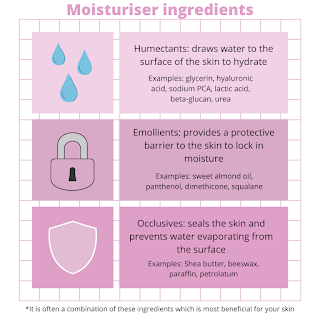Key Ingredients In Skin Care
You will notice that cosmetic products display their contents in a list in accordance with the International Nomenclature of Cosmetic Ingredients (INCI). Ingredients are listed in order of highest to lowest concentrations, usually by their chemical name. You don't know the exact quantities usually used in a product but beneficial ingredients near the top of the list indicates a higher concentration within that product.
Skincare products are essentially various ingredients working synergistically to produce a specific outcome. They often consist of a vehicle which incorporates key ingredients depending on the needs of the product.
For example, a moisturiser will contain humectants or emollients and other ingredients claiming to provide the consumer with a boost of hydration.
It is useful to know a type of ingredient and how it may benefit you when selecting skincare products. What do you want your product to do for you? Here are some key ingredients and their potential benefits.
Moisturisers
There are a few different types of moisturizing ingredients broken down into sub categories:
Humectants
These work by drawing water to the surface of the skin allowing skin to become more hydrated and moisturised.
Key ingredients: glycerin, hyaluronic acid, propylene glycol, aloe vera, urea
Emollients
They work by reducing moisture evaporation from the surface of the skin. Key ingredients: shea butter, ceramides, squalene, fatty acids, triglycerides
Occlusives
They create a barrier over the skin surface to trap moisture. Key ingredients: mineral oil, petrolatum, silicone, lanolin, beeswax.
Cleansing agents
The main cleansing agents are surfactants which trap dirt and grime, removing them from the surface of the skin. Common ingredients include Sodium Lauroyl Sarcosinate, Sodium Laureth Sulfate and Coco glycoside.
Vitamin ingredients
Vitamin A (Retinol) is an antioxidant which can prevent the harmful effects of free radicals on the skin. It can help combat wrinkles and aid in production of the skin's structural protein, collagen. It can be great for regulating sebum and reducing pigmentation.
Vitamin C (Ascorbic acid) is another powerful antioxidant which helps to keep the skin protected from pollution, irritation and inflammation. It is often used to brighten dull skin and reduce pigmentation and red marks. Vitamin C can regulate production of collagen and is involved in the wound healing process.
Vitamin B3 (Niacinamide) has a number of benefits when applied to the skin including increasing ceramides levels, improving the skin barrier and reducing water loss from the surface. It may also reduce sebum production so beneficial for oily skin. There is some evidence that niacinamide helps to visibly minimise pores and improve uneven skin tone.
Essential Fatty Acids
EFAs (Linoleic acid) are important building blocks of ceramides which strengthen and smooth the skin's surface layers. They also help to retain moisture and improve skin elasticity and suppleness. A variety of different ceramides are also used in skincare products.
Exfoliants
AHAs (glycolic acid, lactic acid) and BHAs (salicylic acid) help to remove dead cells from the skin's surface by dissolving the 'glue' which holds them in place. This removal leaves the skin looking smoother and brighter. Due to the nature of these products, using them one or twice weekly can sometimes be enough.
UV filters
Chemical sunscreens work by absorbing UV light. Examples include Butyl Methoxydibenzoylmethane (BMDM), Octocrylene, Homosalate
Physical sunscreens work by reflecting and scattering UV light. Examples include Titanium dioxide, Zinc oxide
My tip for getting the most from your skincare is understanding which ingredients may be beneficial at certain times but also getting to know how an ingredient affects your skin is perhaps the ultimate goal.
Michelle
Tonic Skincare Expert










